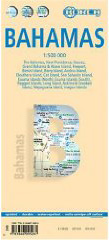- Bahamas Maps
- The Bahama Islands
- Bahamas Real Estate
- Island Facts
- Things To Do
- Restaurants & Dining
- Diving
- Events
- Vacation Villas

Bahamas Maps
|
| |
|
|
People |

Population |

July 2005 estimate: 301,790 people |

Languages |

English, Creole (among Haitian immigrants) |
|
Major Religions |
Baptist 35.4%, Anglican 15.1%, Roman Catholic 13.5%, Pentecostal 8.1%, Church of God 4.8%, Methodist 4.2%, other Christian 15.2%, none or unspecified 2.9%, other 0.8% (2000 census) |
|
Ethnic groups |
black 85%, white 12%, Asian and Hispanic 3% |
|
Population Growth rate |
0.67% (2005 est.) |
|
Birth rate |
17.87 births/1,000 population (2005 est.) |
|
Death rate |
8.97 deaths/1,000 population (2005 est.) |
|
Fertility rate |
2.2 children born/woman (2005 est.) |
|
Male life expectancy |
62.11 years |
|
Female life expectancy |
69.04 years (2005 est.) |
|
Infant mortality rate |
5.21 deaths/1,000 live births |

|
Economy |
|
Economic Overview |
The Bahamas is a stable, developing nation with an economy heavily dependent on tourism and offshore banking. Tourism alone accounts for more than 60% of GDP and directly or indirectly employs half of the archipelago's labor force. Steady growth in tourism receipts and a boom in construction of new hotels, resorts, and residences had led to solid GDP growth in recent years, but the slowdown in the US economy and the attacks of 11 September 2001 held back growth in these sectors in 2001-03. Financial services constitute the second-most important sector of the Bahamian economy, accounting for about 15% of GDP. However, since December 2000, when the government enacted new regulations on the financial sector, many international businesses have left The Bahamas. Manufacturing and agriculture together contribute approximately a tenth of GDP and show little growth, despite government incentives aimed at those sectors. Overall growth prospects in the short run rest heavily on the fortunes of the tourism sector, which depends on growth in the US, the source of more than 80% of the visitors. In addition to tourism and banking, the government supports the development of a "third pillar," e-commerce. |

Labor force |

136,900 (1993) |
|
Unemployment rate |
15.0% (1995) |
|
Inflation Rate |
1.5% (1994) |
|
Gross domestic product (total value of goods and services produced annually) |
$4.4 billion (1994 est.) |
|
Budget |
$725.0 million (1996 est.) |
|
Debt |
$407.8 million (1996) |
|
Exports |
$224.3 million (1996 est.), primarily pharmaceuticals, cement, rum, crawfish, refined petroleum products |
|
Imports |
$1.1 billion (1996 est.), primarily foodstuffs, manufactured goods, crude oil, vehicles, electronics |
|
Defense spending |
2.7% of GDP (1994 est.) |
|
Highways |
2,400 km (1995) |
| |
|
|
Government |

The Bahamas are a Commonwealth. There are 21 administrative divisions: Acklins and Crooked Islands, Bimini, Cat Island, Exuma, Freeport, Fresh Creek, Governor's Harbour, Green Turtle Cay, Harbour Island, High Rock, Inagua, Kemps Bay, Long Island, Marsh Harbour, Mayaguana, New Providence, Nicholls Town and Berry Islands, Ragged Island, Rock Sound, Sandy Point, San Salvador and Rum Cay .
Executive branch: chief of state: Queen ELIZABETH II (since 6 February 1952), represented by Governor General Dame Ivy DUMONT (since NA May 2002)
head of government: Prime Minister Perry CHRISTIE (since 3 May 2002) and Deputy Prime Minister Cynthia PRATT (since 7 May 2002)
cabinet: Cabinet appointed by the governor general on the prime minister's recommendation
elections: none; the monarch is hereditary; governor general appointed by the monarch; following legislative elections, the leader of the majority party or the leader of the majority coalition is usually appointed prime minister by the governor general; the prime minister recommends the deputy prime minister
Legislative branch: bicameral Parliament consists of the Senate (16-member body appointed by the governor general upon the advice of the prime minister and the opposition leader for five-year terms) and the House of Assembly (40 seats; members elected by direct popular vote to serve five-year terms); the government may dissolve the parliament and call elections at any time
elections: last held 1 May 2002 (next to be held by May 2007)
election results: percent of vote by party - PLP 50.8%, FNM 41.1%, independents 5.2%; seats by party - PLP 29, FNM 7, independents 4
International organization participation: ACP, C, Caricom, CDB, FAO, G-77, IADB, IBRD, ICAO, ICCt (signatory), ICFTU, ICRM, IFC, IFRCS, ILO, IMF, IMO, Interpol, IOM, IOC, ITU, LAES, MIGA, NAM, OAS, OPANAL, OPCW (signatory), UN, UNCTAD, UNESCO, UNIDO, UPU, WCO, WHO, WIPO, WMO, WTO (observer) |
| |
|
Geography |

The Bahamas are an island chain (specifically a coral archipelago) in the North Atlantic Ocean, southeast of Florida, with a land area slightly smaller than that of Connecticut.
The Bahamas various islands (over 700 total) have a total surface of 13,940 sq km. See the map page for details of the islands positions.
|
|
|
|
|
|

